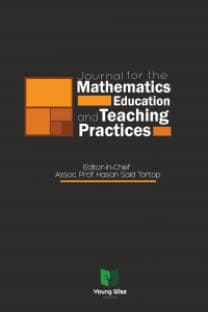Geometric thinking levels among college of education students
Geometric thinking levels among college of education students
geometry, Van Hiele theory, geometric thinking levels of thinking.,
___
- Barbash, M. (2003). Euclidean geometry as a basis of didactic teaching at primary school. A national conference: Training of mathematics teachers in primary school. Oranim College.
- Burger, W.F. & Shaughnessy, J.M. (1986). Characterizing the Van Hiele Leevels of Development in Geometry, Journal for Research in Mathematics Education, 17, 31-48.
- Clements, D.H. & Sarama, J. (2000). Young Children's Ideas about Geometric Shapes. Teaching Children Mathematics, 6(8), 482-488.
- Crowley, M.L. (1987). The Van Hiele Model of the Development of Geometry Thoughts. NCTM Yearbook (pp.1-16). NCTM.
- David, H. (2007). Using the errors of students as a lever to improve learning and deepen mathematical knowledge. AL"H=Newsletter for math teachers, 37, 81-92.
- Hershkovitz, R. (1992). Cognitive aspects of teaching and learning Geometry, Part II. AL"H=Newsletter for math teachers, 10, 20-27.
- Hershkovitz, R. (1991). Cognitive aspects of teaching and learning Geometry, Part I. AL"H=Newsletter for math teachers, 9, 28-34.
- Hershkovitz, R. (1987). The theory of Van Hiele learning geometry. In A. Friedlander (Ed.), Teaching Geometry – A collection of sources and methodology lessons Activities. Weizmann Institute of Science.
- Hershkovitz, R. & Vinner, S. (1984). Children’s concept in Elementary Geometry: A Reflection of Teacher’s Concepts? In B. Southwell, R. Eyland, M. Cooper, J. Conroy & K. Collis (Eds.), Eichth International Conference for the P.M.E. (pp. 63-69). Mathematics Association of New South Wales.
- Lester, F. (Ed.). (2007). Second handbook of research in mathematics learning and teaching. National Council of Teachers of Mathematics.
- Patkin, D. (1990). The effect of computer use at self-learning in individual learning system or couples about perception and understanding of Euclidean geometry concepts at different thinking levels among high school students. Doctoral thesis. Tel Aviv University.
- Patkin, D. (1994). The effect of computer use on geometric thinking levels, AL"H=Newsletter for math teachers, 15, 29-36.
- Reis, R., Van Dormoln-Brahmi, N. & Patkin, D. (1997). To do math: The Van Hiele theory and teaching of geometry. Tomorrow, 98 - a model to promote mathematics education, secondary school. Technion.
- Senk, S.L. (1984). Research a Curriculum Development Based on the van Hiele Model of Geometric Thought. Prepared for the Working Group on Geometry, Spatial Awareness and Visualization. Fifth International Congress on Mathematics Education, Adelaide.
- Skemp, R. (1978). Relational Understanding and Instrumental Understanding. Arithmetic Teacher, 26(3), 9-15.
- Tepper, A. (1986). Color effects and computer-oriented teaching impact on the understanding of Euclidean geometry concepts. MA thesis. School of Education, Tel Aviv University.
- Thomas, B.F. (2000). Implications of Research on Children Understands of Geometry. Teaching Children Mathematics, 6(9), 572-576.
- Usiskin, Z. (1982). Van Hiele Levels and Achievement in Secondary School Geometry (Final Report). University of Chicago.
- Usiskin, Z., & Senk, S. (1990). Evaluating a test of van Hiele levels: A response to Crowley and Wilson. Journal for Research in Mathematics Education, 21(3), 242-45.
- Vinitzky, G. & Reiss, R. (2003). Perceptions of concepts in geometry math teachers. A national conference: Training of mathematics teachers in primary school. Oranim College.
- Vinner, S. (1993). The teaching of mathematics - Thoughts and phenomena from the diary of a teacher researcher. AL"H=Newsletter for math teachers, 12, 23-27.
- Vinner, S. (1991). The Role of Definitions in the Teaching and Learning of Mathematics. In D. Tall (Ed.), Advanced Mathematical Thinking (pp. 65-81). Kluwer.
- Vinner, S. & Hershkovitz, R. (1983). On concept formation in geometry. Zentralblatt feur didacttik der mathematik,
- Yayın Aralığı: Yılda 2 Sayı
- Başlangıç: 2020
- Yayıncı: Genç Bilge Yayıncılık
Investigation of the effect of Go (Baduk) education on problem solving processes and thinking styles
Firuze GÜRBÜZEL, Tuğba SADAK, Atilla ÖZDEMİR
Geometric thinking levels among college of education students
The Microsoft form as a scaffolding-based geometry learning media in online learning
Subhanudin SUBHANUDİN, A. Rasul A. RASUL, Ruben SOND, Habibi SUTİRTA
Role, need and benefits of mathematics in the development of society
